The Resurgence of Analog Hobbies in a Digital World
In an era dominated by screens and digital experiences, a surprising trend is emerging: the revival of analog hobbies. From vinyl record collecting to film photography, people are rediscovering the joy of tangible, hands-on activities. Read below to explore this fascinating shift in leisure pursuits and understand why analog hobbies are making a comeback in our increasingly digital society.

The Allure of the Tangible
In a world where most of our interactions and experiences are mediated through digital interfaces, there’s a growing desire for activities that engage our senses in a more direct, physical way. Analog hobbies offer a tactile experience that digital pursuits simply can’t replicate. The feel of a vinyl record, the smell of old books, or the satisfaction of developing a photograph in a darkroom – these sensory experiences create a deeper connection to the activity and the end product.
Moreover, analog hobbies often require a level of patience and dedication that’s becoming increasingly rare in our instant-gratification culture. This slower pace can be therapeutic, providing a much-needed respite from the constant barrage of notifications and updates that characterize our digital lives. For many, the process of learning and mastering an analog skill becomes a form of mindfulness practice, allowing them to focus on the present moment and find a sense of flow that’s often elusive in digital activities.
The Social Aspect of Analog Hobbies
While digital technologies have revolutionized how we connect with others, they’ve also led to a sense of isolation for many. Analog hobbies are bringing people together in physical spaces, fostering face-to-face interactions and building communities around shared interests. Book clubs, knitting circles, and board game nights are experiencing a resurgence, providing opportunities for people to connect in meaningful ways beyond the confines of social media.
These gatherings often attract diverse groups of people, spanning different age groups and backgrounds, united by their shared passion. This intergenerational and cross-cultural exchange enriches the hobby experience and contributes to a sense of community that many find lacking in their digital interactions. Moreover, the shared experience of learning and improving together creates bonds that often extend beyond the hobby itself, leading to lasting friendships and support networks.
The Quest for Authenticity and Uniqueness
In an age of mass production and digital replication, there’s a growing appreciation for the unique and the handmade. Analog hobbies often result in one-of-a-kind creations, whether it’s a hand-knitted sweater, a carefully curated vinyl collection, or a set of homemade candles. This emphasis on individuality and craftsmanship appeals to those seeking to express their personality and creativity in a world that can sometimes feel homogenized.
Furthermore, the imperfections inherent in many analog pursuits are increasingly seen as a virtue rather than a flaw. The slight warping of a vinyl record or the grain in a film photograph adds character and authenticity that many find lacking in the polished perfection of digital media. This appreciation for the “perfectly imperfect” reflects a broader cultural shift towards valuing authenticity and embracing the human element in our creations and experiences.
The Environmental and Ethical Considerations
The resurgence of analog hobbies also aligns with growing environmental and ethical concerns. Many analog pursuits encourage reuse, repair, and sustainability. For instance, the renewed interest in secondhand books and vintage clothing not only satisfies the desire for unique items but also promotes a more sustainable approach to consumption. Similarly, hobbies like gardening and beekeeping connect people directly with nature and environmental issues.
There’s also an ethical dimension to this trend. As consumers become more aware of the environmental and social costs of digital technologies – from the energy consumption of data centers to the labor conditions in electronics manufacturing – analog hobbies offer a way to engage in leisure activities with a potentially lower environmental impact and clearer ethical implications. This doesn’t mean analog hobbies are without their own environmental considerations, but for many, they represent a more mindful and intentional approach to leisure time.
The Integration of Analog and Digital
Interestingly, the revival of analog hobbies doesn’t necessarily mean a complete rejection of digital technologies. Instead, we’re seeing a fascinating integration of analog and digital elements. Online communities dedicated to analog hobbies are thriving, allowing enthusiasts to share tips, showcase their work, and connect with like-minded individuals globally. Digital tools are being used to enhance analog experiences – for example, apps that help vinyl collectors manage their collections or digital cameras that mimic the aesthetics of film photography.
This blending of analog and digital reflects a broader trend towards finding a balance between the two realms. Rather than viewing them as mutually exclusive, many are discovering ways to leverage the strengths of both. The result is a rich tapestry of experiences that combines the tactile satisfaction and mindfulness of analog pursuits with the connectivity and convenience of digital platforms.
- Start small: Begin with one analog hobby that interests you and gradually expand your interests.
- Join local groups or clubs related to your chosen analog hobby to meet like-minded individuals.
- Embrace imperfection: Remember that the charm of many analog hobbies lies in their imperfections.
- Consider the environmental impact: Choose hobbies that align with sustainable practices.
- Document your journey: Use digital platforms to share your analog hobby experiences and connect with a wider community.
- Explore intergenerational learning opportunities: Many older individuals have valuable skills and knowledge in traditional crafts and hobbies.
- Balance your time: Aim for a healthy mix of digital and analog activities in your daily life.
- Be patient: Many analog hobbies require time and practice to master – enjoy the learning process.
As we navigate an increasingly digital world, the resurgence of analog hobbies offers a compelling counterpoint to our screen-dominated lives. These pursuits provide not just a nostalgic nod to the past, but a meaningful way to engage with the physical world, foster community connections, and express individual creativity. The integration of analog hobbies into our digital lives represents a nuanced approach to modern living, one that values both technological progress and timeless human experiences. As this trend continues to evolve, it will be fascinating to see how it shapes our understanding of leisure, creativity, and connection in the 21st century.




